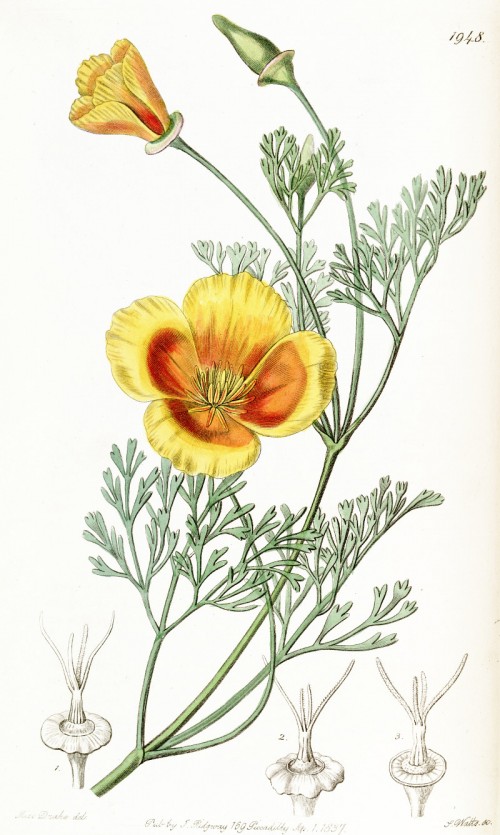Dies ist eine alte Version des Dokuments!
Eschscholzia californica Cham. - Papaveraceae - California poppy, golden poppy, Kalifornische Mohn, Kalifornischer Kappenmohn, Goldmohn, Schlafmützchen
Annual or short-lived perennial herb, up to 60cm high, native to Northern America (California, Mexico), naturalized in Hawaii, cultivated as courtyard ornamentals elsewhere; leaves tripinnatipartite, lobes various, acutely linear, acutely oblong, or obtusely spatulate-oblong; flowers yellow to orange, usually with orange spot at base.
„Native Americans used Eschscholzia californica (no varieties specified) to treat lice, to induce sleep in children, as a poison, for consumption, for toothaches, and as an emetic (D. E. Moerman 1986).“
http://www.efloras.org/florataxon.aspx?flora_id=1&taxon_id=220004967
„This species is widely cultivated in temperate and Mediterranean-type gardens. Cultivated forms include those with single and semi-double flowers in a wide range of colors from white and cream to yellow, orange, red, pink, and purple.“
http://www.efloras.org/florataxon.aspx?flora_id=2&taxon_id=220004967
„Eschscholzia californica was the first named member of the genus Eschscholzia, named by the German botanist Adelbert von Chamisso after the Baltic German botanist Johann Friedrich von Eschscholtz, his friend and colleague on Otto von Kotzebue’s scientific expedition to California and the greater Pacific in mid-1810s aboard the Russian ship Rurik…“
https://en.wikipedia.org/wiki/Eschscholzia_californica
The herb contains alkaloids (0.29-0.38%), mainly californidine (0.19-0.23%, N-methylated escholtzine) and tertiary nonphenolic bases (0.14-0.15%) like allocryptopine (0.02-0.03%), protopine and escholtzine.
[Hagers Handbuch der Pharmazeutischen Praxis, Springer 2010]
„A 70% ethanol extract of California poppy (Eschscholzia californica) was able to bind to 5-HT1A and 5-HT7 receptors at 100 μg/mL. The subsequent isolation procedure yielded the known alkaloids californidine (1), escholtzine (2), N-methyllaurotetanine (3), caryachine (4), and O-methylcaryachine (5), along with a new pavine alkaloid, 6S,12S-neocaryachine-7-O-methyl ether N-metho salt (7). The structure of 7 was determined by spectroscopic data interpretation, while the absolute stereochemistry was determined by means of circular dichroism. From the results obtained from the radioligand-binding assay of the pure compounds, including the commercially available protopine (6), it was evident that the activity on the 5-HT1A receptor was at least partly due to the presence of the aporphine alkaloid 3, which showed the highest inhibition of [3H]8-hydroxy-2-(di-N-propylamino)tetralin ([3H]8-OH-DPAT) binding with an EC50 value of 155 nM and a Ki of 85 nM.“
[Alkaloids from Eschscholzia c alifornica and Their Capacity to Inhibit Binding of [3H] 8-Hydroxy-2-(di-N-propylamino) tetralin to 5-HT1A Receptors in Vitro., Gafner, S., Dietz, B.M., McPhail, K.L., Scott, I.M., Glinski, J.A., Russell, F.E., Bolton, J.L., Journal of natural products, Vol.69(3), 2006, 432-435]
 Eschscholzia californica Cham. as Chryseis compacta Lindl., Edwards’s Botanical Register, vol.23, t.1948 (1837) [S.A.Drake]
Eschscholzia californica Cham. as Chryseis compacta Lindl., Edwards’s Botanical Register, vol.23, t.1948 (1837) [S.A.Drake]
http://plantgenera.org/species.php?id_species=408833
